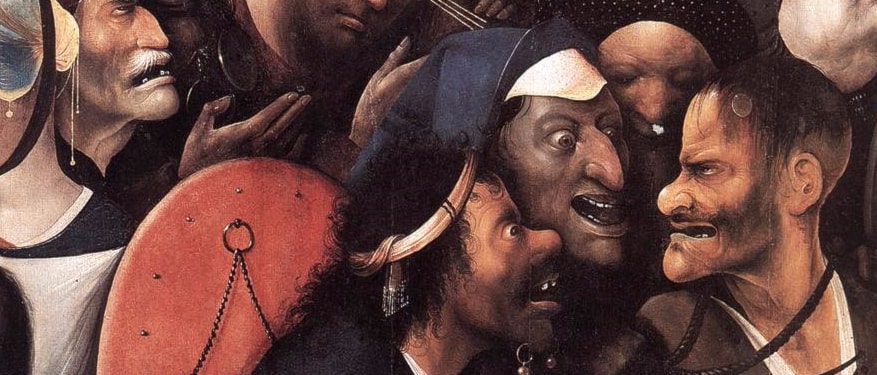The Fine Art of Sneering

Response to New York Times columnist Joe Queenan's Attack on Academic Art
Usually, a criticism of representational art coming from the modernist camp includes at least a pretence at an argument, or some kind of implied standard - such as newness for its own sake, or shock value - which, however wrong it may be, at least acknowledges the human need of standards in the judgment of art. Not so in the case of Joe Queenan's New York Timescolumn, "Rogue's Gallery" (June 4, 2004).
In this column, Queenan lays out a string of negative, empty assertions about the Dahesh Museum collection and concludes that it is "almost too bad to be true," without once explaining his reasons. It's like the high-school hallway technique of scorn, used to intimidate adolescents into anxious conformity ("Look at the geeky shirt that idiot is wearing!") Intimidation is a common weapon among modernists, too, and here Queenan has elevated the adolescent sneer almost to a fine art.
Consider his introduction to the Dahesh, which he calls a
sumptuous collection of spectacularly overwrought [emphasis added] 19th-century artworks. Everywhere I looked there were stoic Moors, winsome virgins, rapacious barbarians, demure shepherdesses.
The one plain fact here is that the Dahesh Museum exhibits works from the 19th century. What does it mean to describe them as overwrought? Does he consider the paintings too ornate or too stylized, or in some way over-painted?
Queenan doesn't say, but he gives a clue to his purpose in his choice of adjectives describing the subjects: the Moors are stoic, the virgins winsome, and so on. Would they be better works of art with a repulsively ugly virgin, perhaps a whiny, nervous Moor, and a brash loudmouthed shepherdess? Why? In what way would that make these paintings better? Would one of Bouguereau's peasant girls be more effective esthetically if she were a screaming fishwife? Obviously not. So what is the purpose of this long stretch of snide remarks? To show contempt, plain and simple. Adolescent intimidation again.
And on and on it goes: Bouguereau's Water Girl is "ghastly"; Cermák's Abduction is "preposterously silly;" and the Museum specializes in "the mawkish, the corny, the over-the-top and the just plain awful." No explanation, just assertions without evidence, intended to intimidate the reader into maligning (or at least, ignoring) the Dahesh, its collection, and academic art in general.
Now, in actual fact, the American public has a keen interest in beautiful, realistic art, as shown by the huge audiences lining up to see the Norman Rockwell exhibit at the Guggenheim, the Sargents and The Victorians at the National Gallery, and the Burne-Joness and Sanford Gifford exhibits at the Met. The art of Bouguereau in particular attracts more visitors to ARC than any other artist. The 228 images in ARC's Bouguereau gallery were visited last year more often than all the images by Monet , Manet , Renoir , and Van Gogh together.
ARC Chairman Fred Ross says Queenan
has managed to write an article without a single new idea, chastising an institution trying to do something different for a change. He recycles the same old hackneyed, shop-worn phrases and pejoratives that have been repeated ad nauseum since the days of Roger Fry and the Guggenheims.
The Dahesh is the only museum in the United States devoted to collecting, exhibiting, and interpreting works by Europe's academically trained artists of the 19th and early 20th centuries. The academic tradition, which dates from the Renaissance, centered on the idealized human figure and on historical, mythological, and religious subjects. This museum is vilified by Queenan for offering a type of artwork that people actually enjoying seeing, unlike the modernistic and nonsensical work being pushed relentlessly by the major museums in London, Paris, Rome and New York City. The Dahesh deserves our accolades and smiles, not sneers.
Queenan says, in summary, that the Dahesh is a museum of "uncompromising twaddle," which is a good description — not of this innovative, feisty and creative museum, but of the content of Queenan's article.
Further Resources
- Queenan, Joe. "Rogue's Gallery." New York Times. July 4, 2004.
- Responses to Mr. Queenan's article printed in the New York Times.
- 1997 Exhibition at the National Gallery, Washington: The Victorians: British Painting in the Reign of Queen Victoria, 1837-1901.
- 1999 Exhibition at the National Gallery, Washington: John Singer Sargent.
- 2001 Exhibition at the Guggenheim: Norman Rockwell: Pictures for the American People.
- 2004 Exhibition at the Metropolitan: Hudson River School Visions: The Landscapes of Sanford R. Gifford.


